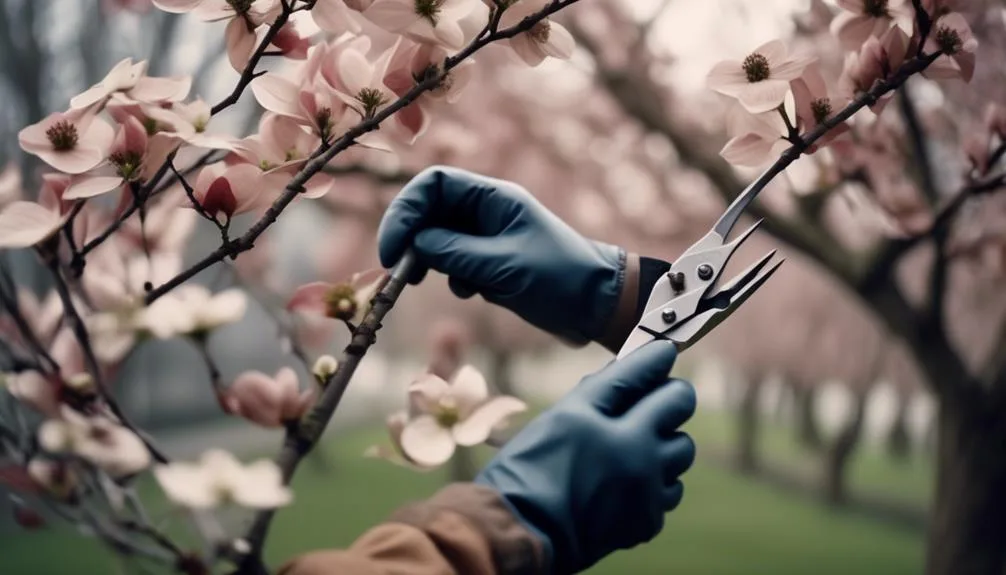Pruning dogwood trees at the wrong time can reduce their flowering. Did you know they should be pruned in late winter or early spring?
Proper pruning is crucial for keeping your dogwood trees healthy and attractive. Whether your trees are young or mature, specific strategies can ensure your pruning efforts have the desired results.
Let's explore the best timing, tools, and techniques for pruning dogwood trees properly to help them thrive in your garden.
Timing for Pruning Dogwood Trees
When considering the timing for pruning dogwood trees, it's essential to be mindful of the specific needs of the tree and the best practices for promoting healthy growth. The best time to prune dogwood trees is during late fall or early winter when the tree is dormant. This timing helps minimize stress on the tree and reduces the risk of disease or pest infestation.
Avoid pruning during the spring and summer, as this is when the tree is actively growing, and pruning during this time can lead to excessive bleeding and weaken the tree. Additionally, it's important to consider the seasonal considerations when pruning dogwood trees to ensure the best results.
Tools Needed for Pruning
To properly prune your dogwood tree, you'll need a few essential tools for the task. Having the right pruning tools ensures that you can execute proper techniques and maintain the health and appearance of your tree. Here are the essential tools you'll need:
- Pruning Shears: These are ideal for cutting small branches and twigs.
- Loppers: Use loppers for cutting thicker branches that are too large for pruning shears.
- Hand Saw: A hand saw is useful for larger branches that can't be handled by loppers.
- Pruning Saw: This saw is designed specifically for pruning, with a narrow curved blade for precision cutting.
- Protective Gear: Gloves, safety goggles, and possibly a helmet are important for your safety while pruning.
Having these tools at hand will ensure that you can effectively and safely prune your dogwood tree.
Techniques for Pruning Young Dogwood Trees
Now that you have the essential tools needed for pruning, let's explore the effective techniques for pruning young dogwood trees.
When pruning young dogwood trees, it's crucial to employ the right methods to ensure the tree's health and proper growth. Start by removing any dead, diseased, or crossing branches. This will improve the tree's overall structure and prevent potential issues.
Additionally, thin out the canopy by selectively removing some branches to allow better air circulation and sunlight penetration. Be mindful not to prune too aggressively, as dogwood trees are sensitive to heavy pruning. Instead, focus on light, strategic pruning to shape the tree and encourage healthy growth.
Always use sharp, clean tools to make precise cuts and minimize the risk of damage or disease.
Techniques for Pruning Mature Dogwood Trees
Looking to ensure the continued health and beauty of your mature dogwood trees? Proper pruning techniques are essential for maintaining the vitality and aesthetics of these trees. When it comes to mature dogwood trees, it's crucial to approach pruning with care and precision to avoid common mistakes that can harm the tree.
Here are some techniques to keep in mind:
- Pruning Benefits: Pruning helps improve the overall structure and appearance of the tree, encourages new growth, and enhances flowering.
- Avoiding Over-Pruning: Be cautious not to remove too much of the tree's canopy, as this can stress the tree and hinder its ability to photosynthesize effectively.
- Removing Diseased or Dead Branches: Regularly inspect the tree for any diseased or dead branches and promptly remove them to prevent the spread of infections.
- Maintaining Natural Shape: Aim to maintain the natural shape of the tree while removing any crossing or rubbing branches.
- Seeking Professional Help: For extensive pruning or if you're unsure about certain branches, consider consulting a professional arborist.
Aftercare and Maintenance
Regularly inspect your dogwood tree for signs of pests, diseases, or other issues, and take appropriate measures to address them promptly.
Set up a consistent watering schedule for your dogwood tree, especially during dry spells. Water deeply, allowing the soil to dry slightly between waterings to prevent root rot. In the tree's first few years, water it regularly to establish a strong root system.
During the growing season, apply a balanced fertilizer to the soil around the tree, following the manufacturer's instructions. Avoid using high-nitrogen fertilizers, as they can disrupt the tree's natural growth pattern. Fertilize in early spring before new growth emerges.
Proper watering and fertilization will help keep your dogwood tree healthy and resilient against pests and diseases.
Conclusion
Incorporating the right timing, tools, and techniques for pruning dogwood trees will ensure their health and visual appeal.
Remember, pruning young trees establishes a strong structure, while maintaining the shape and size of mature trees is key.
With proper care, your dogwood trees will flourish for years to come.
Happy pruning!

My interest in trees started when I first saw the giant sequoias in Yosemite.
I was a teenager then, and I remember thinking, “I need to learn more about this.”
That moment stuck with me.
A few years later, I went on to study forestry at Michigan Tech.
Since graduating, I’ve worked in a mix of hands-on tree care and community education.
I’ve spent over ten years helping people understand how to plant, maintain, and protect the trees in their neighborhoods.
I don’t see trees as just part of the landscape.
They are living things that make a real difference in our daily lives.
